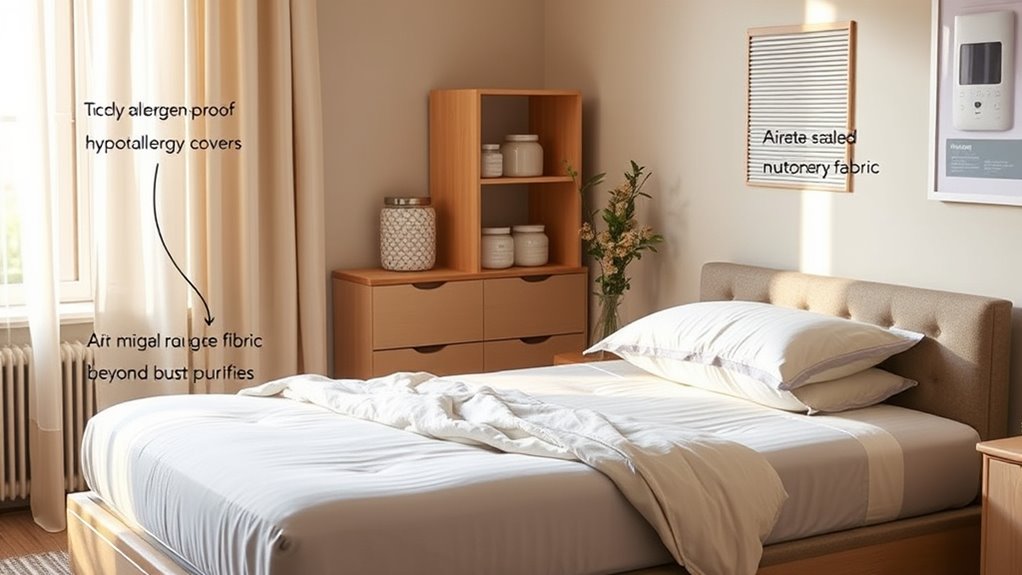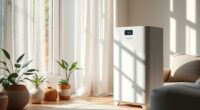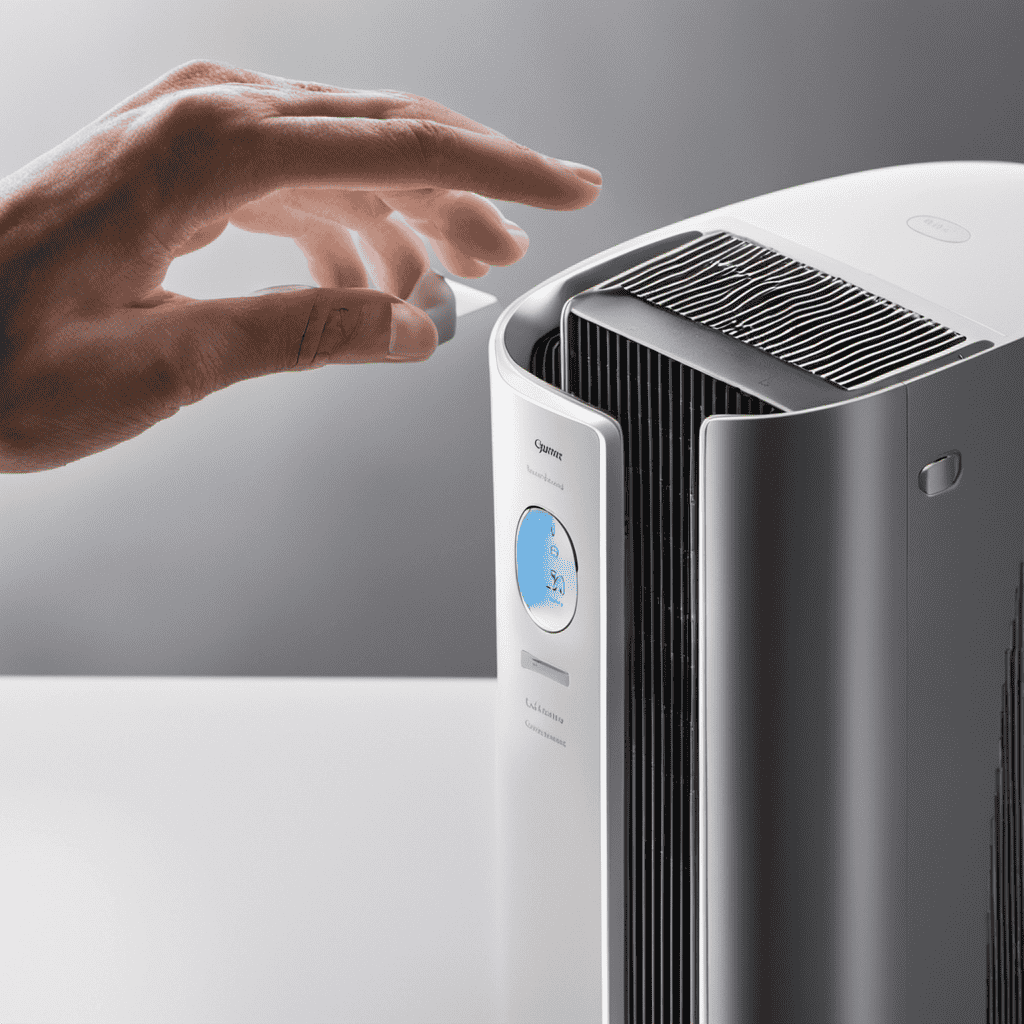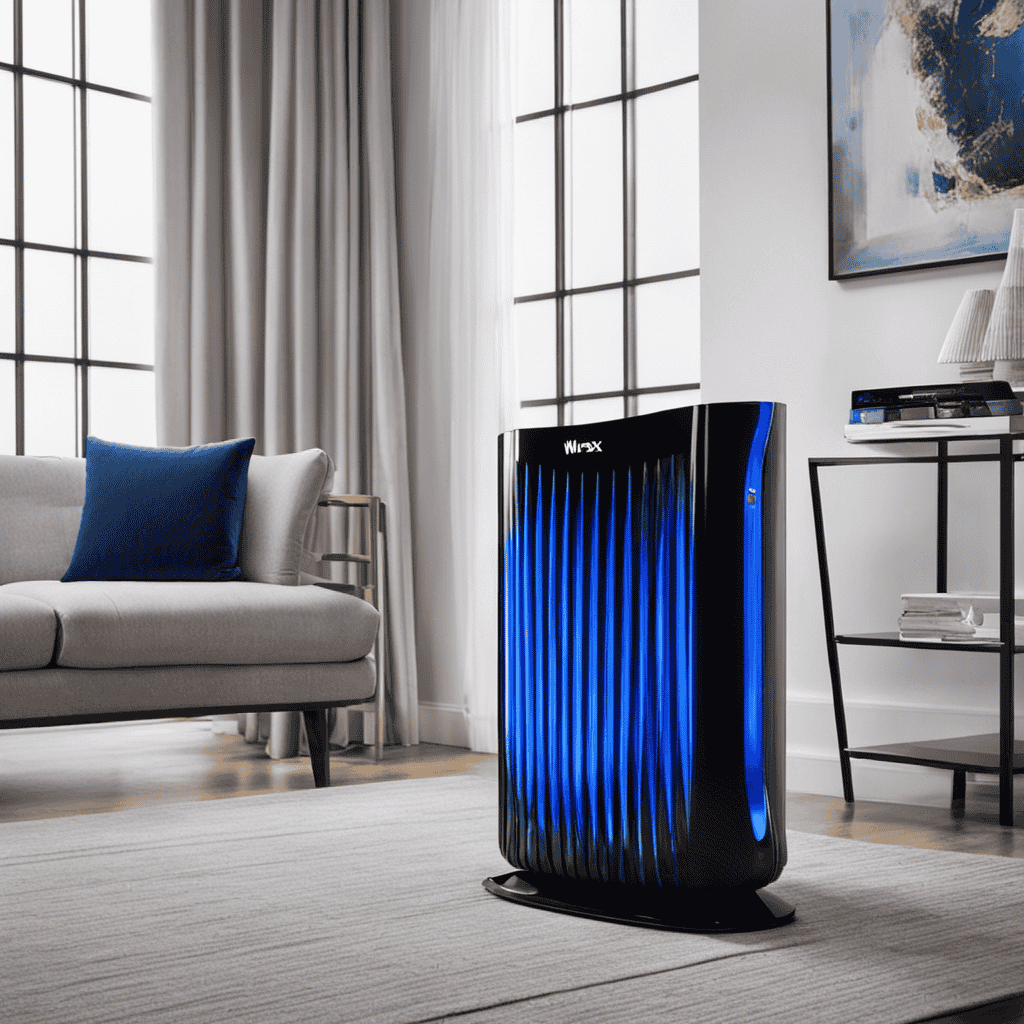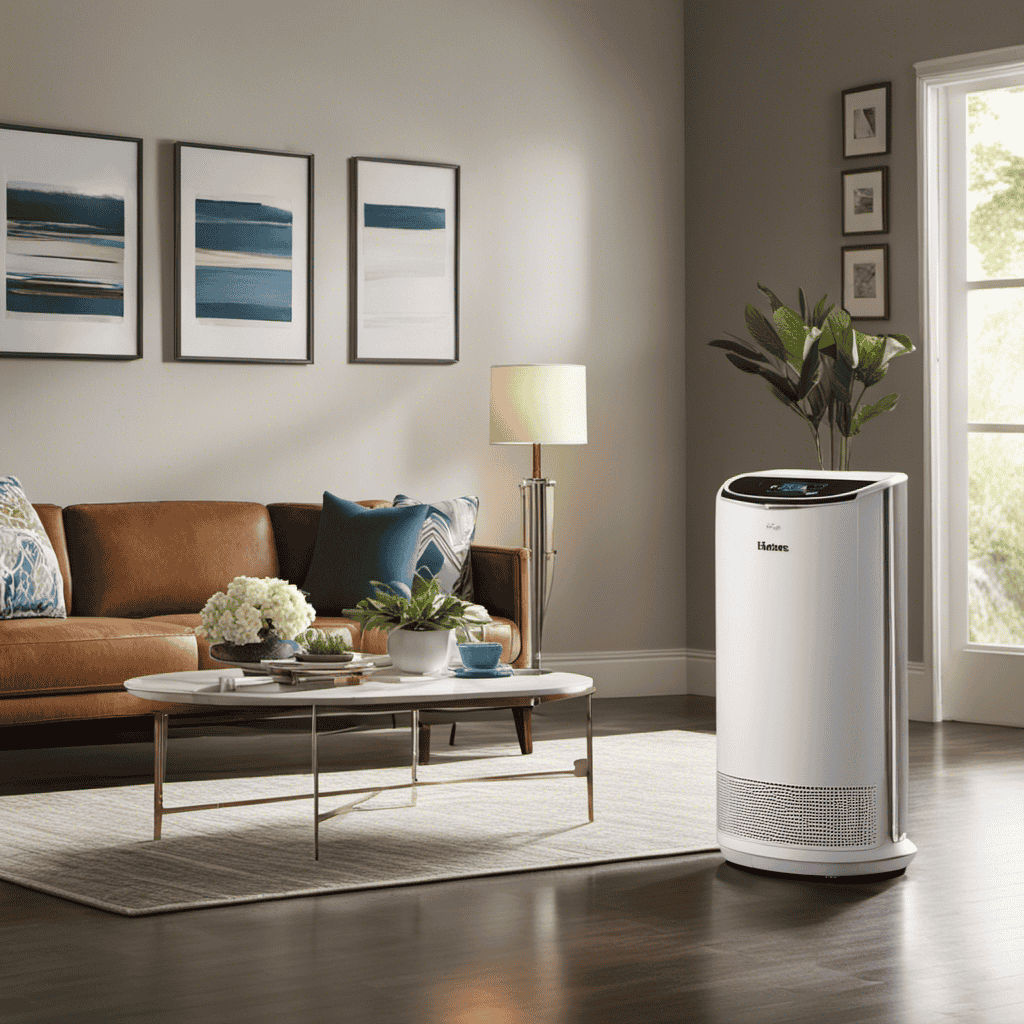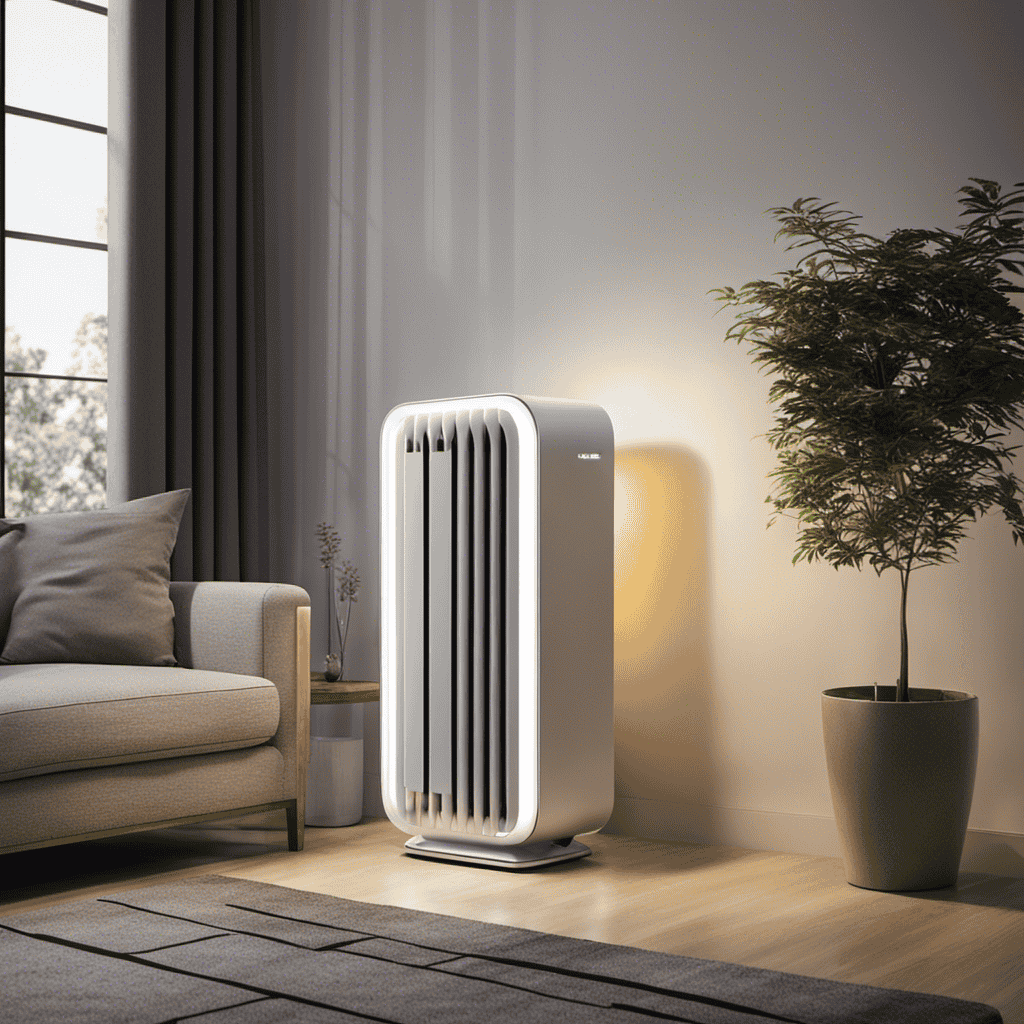To allergen-proof your home beyond air purifiers, focus on regular cleaning, like dusting with damp cloths and vacuuming with HEPA filters. Use allergen-resistant bedding and fabrics, keep humidity between 30-50%, and fix leaks to prevent mold. Improve airflow with proper ventilation, close gaps around windows and doors, and limit pet access to bedrooms and furniture. Incorporate natural barriers and moisture control—stay tuned to discover more effective strategies to create a healthier environment.
Key Takeaways
- Use allergen-proof bedding covers and wash bedding weekly in hot water to reduce dust mites and pet dander.
- Maintain indoor humidity between 30-50% with dehumidifiers to prevent mold growth and dust mite proliferation.
- Regularly vacuum with HEPA-filter vacuums and wipe surfaces with damp cloth to trap dust particles effectively.
- Seal gaps around windows, doors, and vents with caulk or weatherstripping to block allergen entry points.
- Improve ventilation with exhaust fans and open windows when possible to reduce indoor allergens and improve air quality.
Regular Cleaning and Dust Control
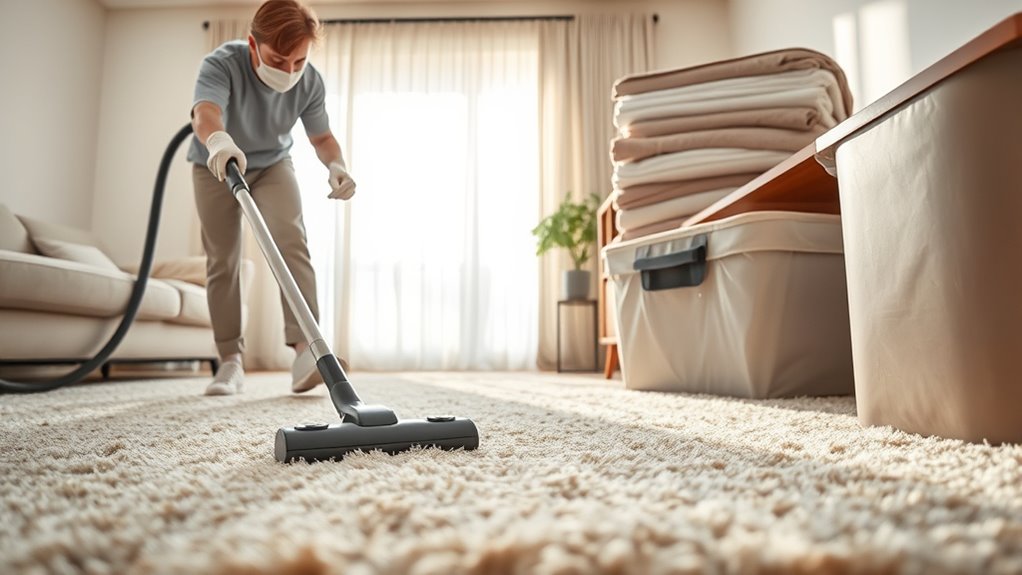
Regular cleaning and dust control are essential steps in reducing allergens in your home. Start by dusting surfaces regularly with a damp cloth to trap dust particles instead of spreading them around. Vacuum frequently using a vacuum equipped with HEPA filters, which effectively capture tiny allergens like dust mites and pet dander. Air purifiers with HEPA filters can also help by continuously filtering airborne allergens, improving overall air quality. Don’t forget to clean ceiling fans, vents, and HVAC filters to prevent dust buildup. Keep clutter to a minimum, as it collects dust easily. Regularly wiping down furniture and fabrics reduces allergen accumulation. Incorporating digital literacy programs can also assist seniors in understanding how to better use air purifiers and other allergen-reducing devices. Additionally, choosing hypoallergenic bedding and washing it regularly can further limit allergen exposure. Maintaining proper ventilation is crucial for dispersing indoor allergens and promoting healthier airflow. Proper home organization also helps reduce dust accumulation in hard-to-reach areas. Implementing air quality monitoring can help you identify high allergen levels and take targeted actions. Regular cleaning creates a cleaner environment and helps keep allergens at bay, making your home healthier and more comfortable.
Choosing Allergen-Resistant Bedding and Fabrics
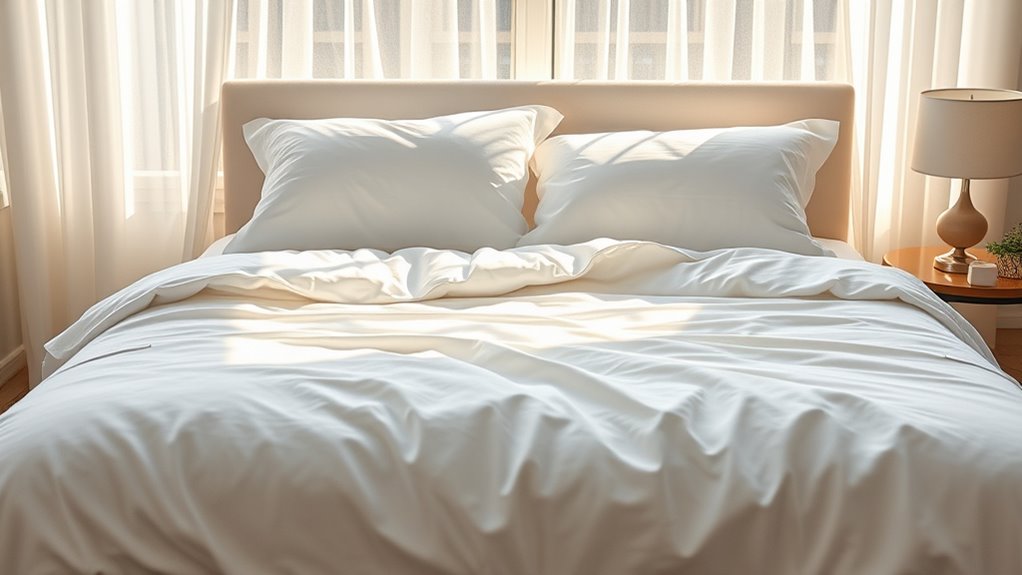
Choosing allergen-resistant bedding and fabrics can make a big difference in reducing indoor allergens. You should look for hypoallergenic materials and wash your bedding regularly to keep dust mites and pet dander at bay. These simple steps help create a healthier sleeping environment for you. Incorporating cozy textiles like blankets and throws made from natural, allergen-resistant fabrics can further enhance comfort while maintaining a clean sleeping area. Additionally, selecting fabrics with exfoliating properties can aid in reducing surface allergens and improve overall hygiene, especially when combined with proper laundering techniques. Utilizing antimicrobial treatments on fabrics can also help inhibit the growth of mold and bacteria, further reducing allergen levels. Leveraging AI-driven insights can also help identify the most effective cleaning schedules and materials for your specific environment.
Opt for Hypoallergenic Materials
Since allergens often cling to bedding and fabrics, opting for hypoallergenic materials can substantially reduce your home’s allergen levels. Choose hypoallergenic bedding and fabrics made from natural or synthetic materials designed to resist dust mites, mold, and pet dander. Additionally, consider installing hypoallergenic flooring options like vinyl or cork, which are less likely to trap allergens. When painting, select non-toxic paints to prevent airborne irritants. Using these materials creates a cleaner, safer environment for allergy sufferers. Incorporating air filtration systems can further enhance allergen reduction throughout your home. Here’s a quick comparison:
| Material Type | Benefits |
|---|---|
| Hypoallergenic bedding | Reduces dust mites and dander |
| Hypoallergenic flooring | Easy to clean, less allergen buildup |
| Non-toxic paints | Improves indoor air quality |
| Hypoallergenic fabrics | Prevents allergen accumulation |
Wash Bedding Regularly
Did you know that washing your bedding frequently can substantially reduce allergens in your home? Dust mites thrive in bedding, feeding on dead skin cells, and contribute to allergy symptoms. By washing sheets, pillowcases, and blankets weekly in hot water, you effectively allergen proof your bedding and minimize dust mite populations. Use allergen-resistant fabrics like tightly woven cotton or specialized allergen-proof covers to block mites and their allergens. Regular laundering removes dust mite feces and body parts, which are common triggers. Incorporating sound vibrations best practices, such as cleaning bathroom surfaces regularly, can also help reduce indoor humidity and discourage dust mites. This simple routine is a powerful step in allergy management, helping you breathe easier and reducing symptoms. Incorporating frequent washing into your allergen-proofing strategy keeps your sleeping environment cleaner and healthier.
Managing Humidity and Preventing Mold Growth
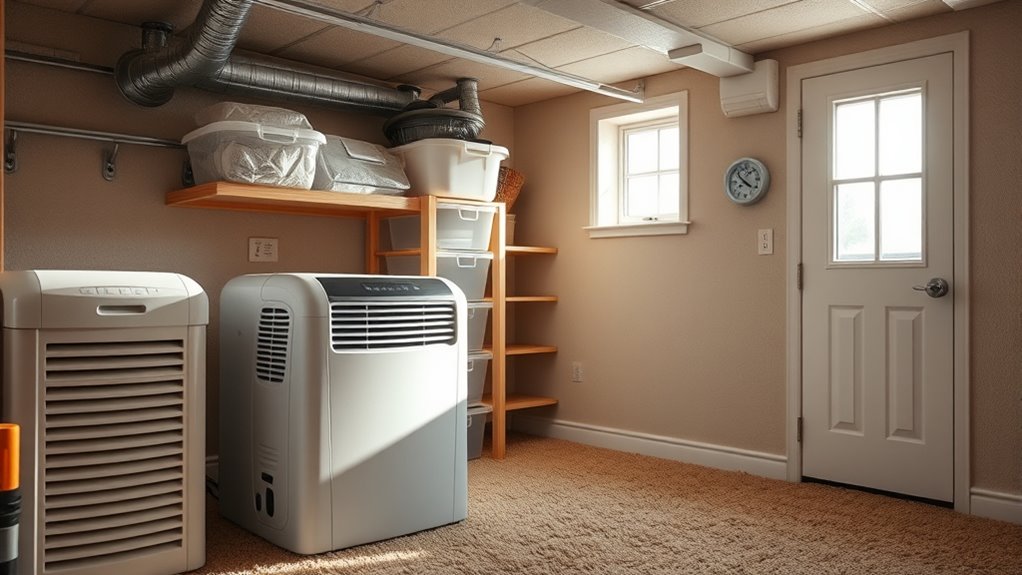
Keeping indoor humidity in check is key to preventing mold growth. Make sure your home is well-ventilated and fix any water leaks immediately. By managing moisture, you create a healthier environment free from mold and allergens. Additionally, controlling humidity levels can support overall wellness and prevent issues related to excess moisture. Regularly monitoring for signs of spoilage in household items such as lemon juice can also help maintain a safe and healthy living space. Incorporating diverse planters with appropriate drainage can further help in moisture management and prevent water accumulation around plants. Using paint sprayer accessories to ensure proper application of sealants and coatings can further help in waterproofing areas prone to moisture buildup.
Control Indoor Moisture Levels
Controlling indoor moisture levels is essential for preventing mold growth and reducing allergens in your home. To do this effectively, consider regular air quality testing to identify excess humidity or mold spores. Maintaining humidity between 30-50% helps inhibit mold development. Using dehumidifiers and exhaust fans can keep moisture in check, especially in areas prone to dampness like kitchens and bathrooms. Incorporate indoor plants with benefits that include natural humidity regulation, but don’t overwater them. Properly sealing leaks and ensuring your home isn’t overly damp minimizes mold risk. Additionally, choosing water-resistant materials for home renovations can further reduce moisture intrusion. Regularly inspecting your home for leaks and moisture control issues is crucial in maintaining a healthy environment. Implementing proper ventilation strategies enhances airflow and helps keep indoor humidity levels balanced. By managing moisture, you improve overall air quality and create a less hospitable environment for allergens. Keeping humidity levels balanced is a simple yet crucial step toward a healthier, allergen-reduced home.
Promote Proper Ventilation
Proper ventilation plays a key role in managing indoor humidity and stopping mold from taking hold. You should guarantee regular air exchange by using effective ventilation systems, such as exhaust fans or dehumidifiers, especially in high-moisture areas like bathrooms and kitchens. Good airflow reduces excess moisture that mold thrives on. Keep windows open when weather permits to promote natural ventilation, and consider installing ventilation systems that improve airflow even when windows are closed. Proper ventilation helps remove stale, humid air and introduces fresh air, preventing the buildup of moisture that can lead to mold growth. Regularly maintaining and using these systems ensures your home stays dry and allergen-free, creating a healthier environment for you and your family. Incorporating high water content vegetable juices into your routine can also support overall health and immune function, indirectly aiding in allergy management. Additionally, understanding sector performance metrics can help you identify areas for improvement in your home’s moisture control strategies. Enhancing ventilation efficiency can further optimize your home’s climate control and reduce allergy triggers. Consistent use of air quality monitoring devices can help you track improvements and adjust ventilation practices accordingly, ensuring optimal indoor air conditions. Maintaining proper ventilation also supports air quality, which is essential for reducing airborne allergens and improving overall indoor health.
Address Water Leaks Promptly
Water leaks, if left unaddressed, can quickly raise indoor humidity levels and create ideal conditions for mold to develop. Promptly fixing leaks prevents mold growth and protects your home’s air quality. Regular plumbing maintenance keeps pipes in check and detects leaks early. To manage humidity, use water filtration systems that reduce excess moisture. Check for leaks around sinks, toilets, and appliances regularly. Implementing humidity control methods can further assist in maintaining a dry, mold-free environment. Proper foraging techniques and ventilation strategies are also essential to ensure good air circulation and prevent moisture buildup. Additionally, understanding dehumidification strategies can significantly reduce humidity levels and inhibit mold proliferation.
Pet Care and Dander Reduction Strategies
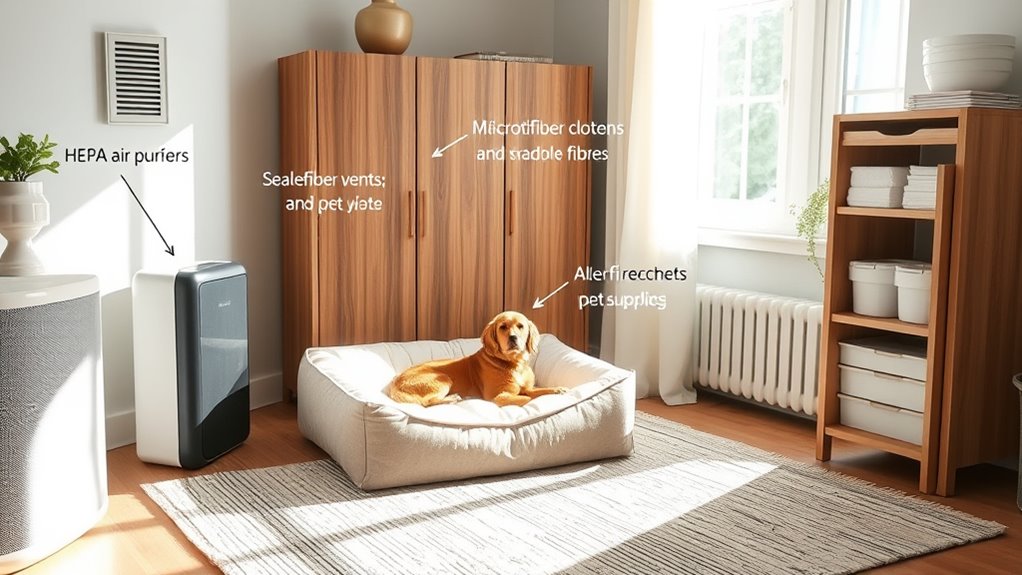
To effectively reduce pet dander in your home, regular grooming and cleaning are essential. Pet grooming, such as bathing and brushing your animals frequently, helps minimize the amount of dander they shed. Use a high-quality brush and pet-safe shampoo to keep dander levels in check. Dander control also involves cleaning your home thoroughly—vacuuming carpets, rugs, and furniture with a HEPA filter vacuum traps pet allergens. Washing your pet’s bedding regularly reduces accumulated dander. Keep pets out of bedrooms and off furniture to limit allergen spread. Establishing a consistent grooming routine and maintaining a clean environment considerably decrease pet dander, making your home more comfortable for allergy sufferers. These proactive measures are key to managing pet allergens effectively.
Enhancing Ventilation and Air Circulation
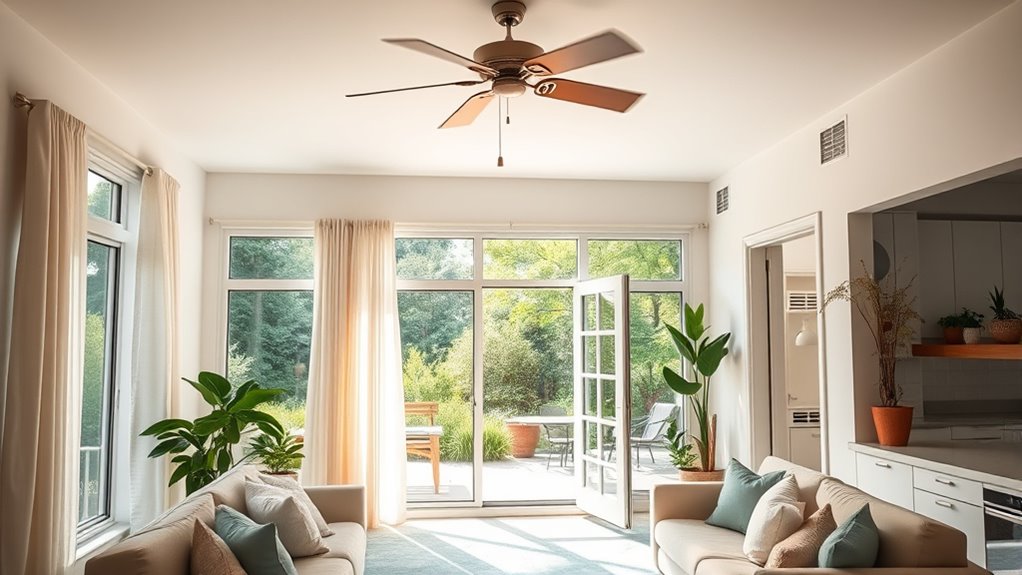
Improving ventilation and air circulation in your home can substantially reduce allergen buildup and improve indoor air quality. By increasing air exchange, you help remove particles like dust, pollen, and pet dander that settle indoors. To optimize airflow, open windows regularly to promote natural ventilation, especially when outdoor air quality is good. Use exhaust fans in kitchens and bathrooms to expel moist, allergen-laden air. Consider installing ceiling fans or air circulators to boost airflow without creating drafts. Proper ventilation prevents stagnant air, which can trap allergens and mold spores. Focus on airflow optimization by ensuring vents are unobstructed and filters are clean. These steps work together to refresh indoor air, making your environment less hospitable to allergens.
Home Improvements to Seal Hidden Allergens
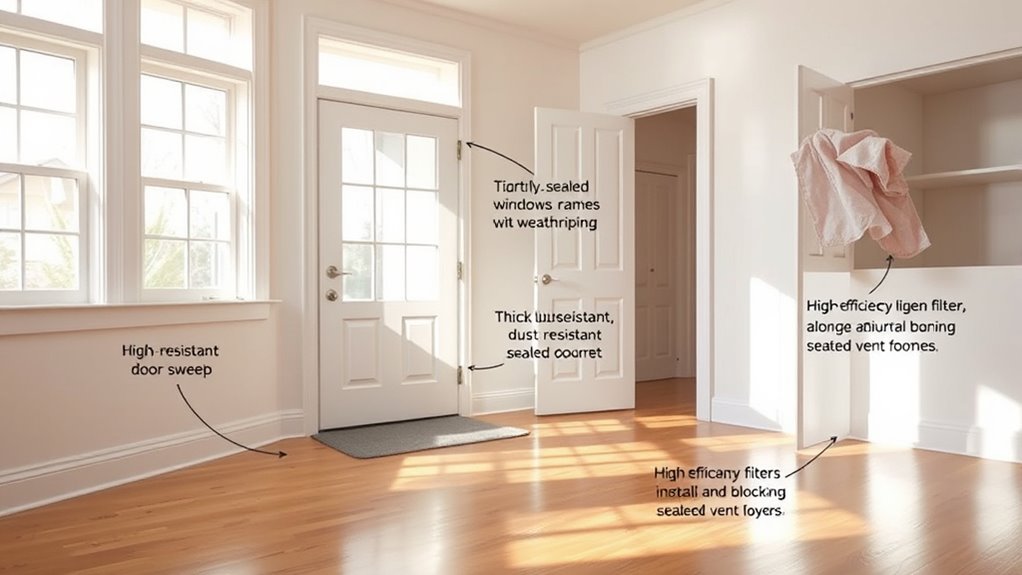
Sealing hidden allergens in your home is essential for creating a healthier living environment. You can achieve this by installing air tight seals around windows, doors, and vents to prevent dust, mold spores, and pet dander from sneaking inside. Check gaps in baseboards, electrical outlets, and plumbing fixtures, and seal them with caulk or weatherstripping. Pay special attention to areas where allergens tend to accumulate, like attic hatches and crawl spaces. These improvements help with hidden allergen removal by blocking entry points and reducing indoor allergen buildup. Regularly inspecting and maintaining these seals ensures they stay effective. By sealing these gaps, you minimize allergen intrusion and create a cleaner, safer home for allergy sufferers.
Incorporating Natural Allergen Barriers
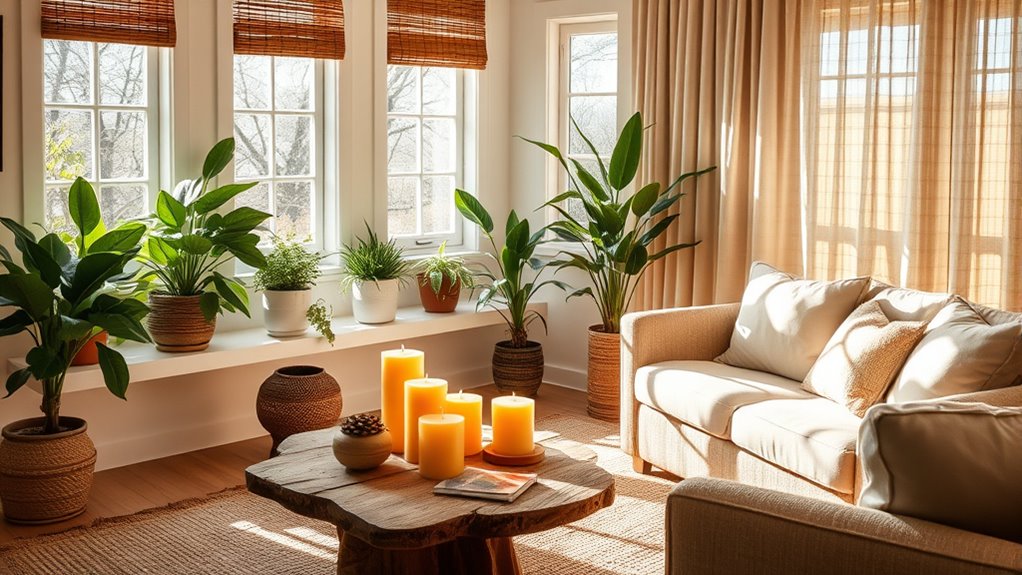
Incorporating natural allergen barriers into your home can considerably reduce indoor allergens without relying solely on synthetic solutions. Plant-based barriers, like densely planted shrubs or herbs, can block pollen and dust from entering doorways and windows. Using natural repellents, such as citronella or eucalyptus, near entry points deters insects that carry allergens. These barriers create a physical and aromatic shield, reducing airborne allergens naturally. Consider placing lavender or mint around windows and vents to further repel pests and allergens.
| Plant-Based Barriers | Natural Repellents |
|---|---|
| Dense shrubs & herbs | Citronella, eucalyptus, lavender |
| Block pollen entry | Deter insects carrying allergens |
| Improve airflow | Enhance natural scent barrier |
| Eco-friendly | Chemical-free allergen defense |
Frequently Asked Questions
How Can I Identify Hidden Allergen Sources in My Home?
To identify hidden allergen sources, start by inspecting common areas like bedding, upholstery, and carpets for dust mite prevention and pet dander control. Look for signs of pet fur or dander buildup, especially in hidden spots like behind furniture. Use allergen test kits or consult an allergist for professional testing. Regular cleaning, vacuuming with HEPA filters, and washing bedding can help uncover and reduce these allergens effectively.
Are There Specific Plants That Help Reduce Indoor Allergens?
Certain indoor plants can help reduce allergens and improve air quality. When choosing indoor plant selection, look for allergen reducing foliage like snake plants, peace lilies, and Boston ferns. These plants naturally filter dust, mold spores, and other allergens from the air. Make certain proper care and placement to maximize their benefits. Incorporating these plants into your home creates a healthier environment, making it easier to breathe and reducing allergy symptoms.
What Are Non-Toxic Methods to Remove Mold From Hidden Areas?
Did you know that mold can grow in hidden spots, affecting indoor air quality? To non-toxically remove mold, try natural remedies like vinegar or baking soda, which kill mold safely. Applying mold-resistant paints can prevent future growth, especially in high-moisture areas. Regularly clean with these non-toxic methods, and keep humidity low. This proactive approach helps you create a healthier home without harsh chemicals.
How Often Should I Replace Allergen-Resistant Bedding?
You should replace your allergen-proof bedding every 6 to 12 months as part of your bedding maintenance routine. Regular washing helps remove dust mites, pollen, and other allergens. Even with allergen-proof bedding, it’s important to check for wear and tear, replacing it promptly when needed. This keeps your sleeping environment healthier and minimizes allergen buildup, ensuring you get restful, allergen-free sleep every night.
Can Certain Cleaning Products Worsen Allergy Symptoms?
Certain cleaning products can worsen allergy symptoms, especially if you have chemical sensitivities. Many commercial cleaners contain fragrances and harsh chemicals that irritate your lungs and sinuses. To reduce this risk, opt for fragrance-free cleaning products and those labeled hypoallergenic. Always read labels carefully, and consider making your own cleaning solutions with natural ingredients like vinegar and baking soda. Fragrance-free cleaning helps create a safer, healthier environment for allergy sufferers.
Conclusion
By taking these steps, you’re creating a home that’s as welcoming as a fortress against allergens. Regular cleaning, smart fabric choices, and good ventilation act like shields, blocking tiny irritants from invading your space. Think of your home as a cozy harbor, where allergens are kept at bay like stormy seas behind sturdy walls. With consistent effort, you’ll breathe easier and enjoy a healthier, more comfortable environment every day.
